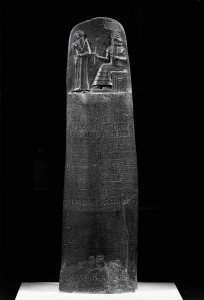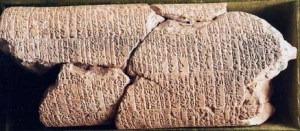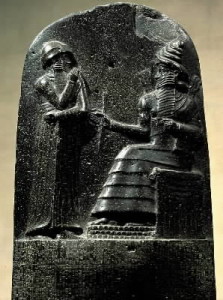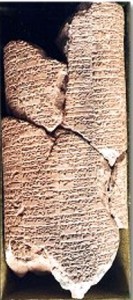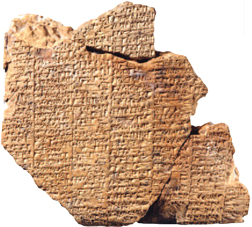The aim of the rulers in Mesopotamia was to assert its ability to organize the social and economic life of the kingdom, under the respect of the gods. In the history of the Near East were promulgated various law codes, the best known is that of Hammurabi of Babylon (concerning his 38th year, in 1754).
The oldest is the code of Ur-Nammu, founder of the Third Dynasty of Ur, lived around 2000 BC. This compendium of laws was very important because it not only presented the laws for different crimes, but it also established the standard measures of capacity and weight. According to some scholars, the code is due, not to Ur-Nammu, but his son Shulghi.
While the Code of Lipit-Ishtar is about 200 years older than the Code of Hammurabi. Lipit-Ishtar was the fifth king of the dynasty of Isin, who lived around 1900 BC. Laws regarding the slave trade, false allegations, the loss of property funds, marriage, inheritance.
These codes are the juridical collections, not just summaries of old and new laws, but a sequence of solutions to crucial problems with norms that are also modified or replaced. For this reason the articles follow each other without any logical continuity. The Code of Hammurabi respect to that of Ur-Nammu or Lipit-Ishtar presents a note of tightening in the penis with the so-called law of talion (the concept of an eye for an eye and a tooth for a tooth), whereas before there was the principle of compensation. The code was a tripartite organization:
- Prologue
- Body of laws
- Epilogue
The prologue focuses and presents the devotion of the sovereign towards the gods who chose him to govern. The epilogue instead contains curses against those who alter or abolish laws issued. Regarding the corpus, the most intact is contained in the stele of Hammurabi. Important points are:
- problems affecting the abuses of corruption (to prevent the exploitation of farmers)
- inheritance rights
- the marriage
- the adoption
In addition there are numerous articles concerning the protection of women. It is likely that these codes were linked statues, presented in lists of year as ” the king statues of justice”. In fact, in a step of the Epilogue of the stele of Hammurabi, the latter mentions a statue placed in the temple of Shamash in Sippar near the code itself; maybe as a guarantor of the established order.
LA LEGISLAZIONE NELL’ANTICA MESOPOTAMIA
Lo scopo dei sovrani in Mesopotamia era quello di affermare la propria capacità di organizzare la vita sociale ed economica del regno, sotto il rispetto degli dei. Nella storia del Vicino Oriente sono stati promulgati vari codici di diritto, il più noto è quello di Hammurabi di Babilonia (relativo alla suo 38 ° anno, nel 1754).
Il più antico è il codice di Ur-Nammu, fondatore della III Dinastia di Ur, vissuto intorno al 2000 a.C. Questo compendio di leggi era molto importante in quanto presentava non solo le leggi per i diversi reati, ma anche perché stabiliva le misure standard di capacità e peso. Secondo alcuni studiosi, il codice è dovuto, non da Ur-Nammu, ma da suo figlio Shulghi.
Mentre il Codice di Lipit-Ishtar è di circa 200 anni più vecchio del Codice di Hammurabi. Lipit-Ishtar fu il quinto sovrano della dinastia di Isin, vissuto intorno al 1900 aC. Le leggi rigurdano la degli schiavi, le false accuse, la perdita della proprietà di fondi , il matrimonio, l’eredità.
Questi codici sono raccolte giuridiche, non una sintesi di leggi vecchie e nuove, ma una serie di diverse soluzioni a problemi cruciali con norme che vengono anche modificate o sostituite. Per questo motivo gli articoli si susseguono senza continuità logica. Il Codice di Hammurabi rispetto a quello di Ur-Nammu o Lipit-Ishtar presenta una nota di inasprimento nelle pene con la cosiddetta legge del taglione (il concetto di occhio per occhio e dente per dente), mentre prima vi era il principio della compensazione. Il codice aveva un’organizzazione tripartita:
- Prologo
- Corpus di leggi
- Epilogo
Il prologo si sofferma e presenta la devozione del sovrano verso gli dei che lo hanno scelto per governare. L’epilogo contiene invece maledizioni contro coloro che alterano o aboliscono le leggi emanate. Per quanto riguarda il corpus, quello più integro è contenuto nella stele di Hammurabi. Punti importanti sono:
- problemi che riguardano i soprusi di corruzione (per evitare lo sfruttamento dei contadini)
- diritti di successione
- il matrimonio
- l’adozione
Inoltre numerosi sono gli articoli che riguardano la tutela delle donne. E ‘probabile che a questi codici fossero collegate delle statue, presentate nelle liste d’anno come “le statue del re di giustizia”. Infatti, in un passo del Epilogo della stele di Hammurabi, quest’ultimo menziona una statua posta nel tempio di Shamash a Sippar vicino al codice stesso; forse come garante dell’ordine stabilito.
